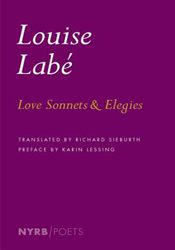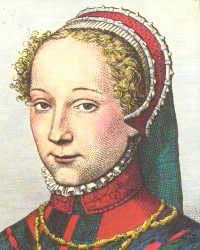
Last week while out at the bar meeting up with poet friends one of them asked what was the last book of poetry to blow me away. I brought Louise Labé: Love Sonnets & Elegies from out my coat pocket and handed it over. Another friend commented that he had just recently translated one of Labé’s sonnets having been turned on to her work in this same book by a mutual friend working at City Lights bookstore. This was hardly surprising. Labé’s poems are readily destined to elicit a phenomenal attraction from readers.
Only a couple weeks previous I had been texting lines of Labé’s, such as “Ainsi Amour inconstamment me meine” (“Inconstant Love is my most constant guide”) and “Pourra, s’il veut, plus vous rendre amoureuses” (“Love alone decides when you lose your mind”), to both my sister and another pal not present at the bar. Discovering Labé’s work is nothing less than enthralling. It’s exactly the sort of experience of poetry you are moved by and immediately want to share. This gem of a book presents an economized, informative introduction to the French woman poet of the 16th century.
While slim, the selection of her work presented is nonetheless substantially bold and compelling. Richard Sieburth’s astutely executed translation is well illuminated by his Afterword. Labé’s writing is found in itself to be quite thrilling enough to read but there’s also a notable bit of recent scholarly controversy surrounding it. French scholar Mireille Huchon, “respected authority on Renaissance literature at the Sorbonne”, argues in her 2006 book Louise Labé: une créature de papier that Labé’s writing is nothing more than a literary hoax worked up by male poets of the era, such as Maurice Scève.
Sieburth presents Huchon’s argument in fair and balanced light leaving the impression that it’s certainly not without merit and a rather intriguing hypothesis. Yet Sieburth also makes a convincing case for his opposition, challenging Huchon’s theory. Having previously rendered Scève’s poems into English and now tackled Labé, he remains definitely “convinced (pace Huchon) that these two poets are not one in the same.”
As he passionately exclaims “Labé’s poems are simply too good, too self-consistent, too singularly themselves, in a word, too different—a difference (to engage for a moment in what feminists call ‘strategic essentialism’) that has to do, among other things, with the fact that she writes and sings as a woman.”
He notes the fact that Labé addresses her poems to “Ladies of Lyon” specifying her work to a locale and individuals found there. Even more importantly, unlike Scève whose “poetry was always in a class by itself–dense, hermetic, and radically silent in the manner of Mallarme: the voice of Nobody, the voice of Language” Labé writes “as a (marginal) woman” drenching her poems “in the vernacular of Villon.” Labé’s work comes heartily alive under Sieburth’s translation but it is in large part of course only owing to the direct, personal address which comes across in her work which he is pointing to in his argument.
Sieburth also demonstrates how richly evocative Labé’s work is of previous poetic traditions. Both her sonnets and elegies are ensconced within familiar poetic tropes and environments familiar to any reader who has perused the works of Lover’s Lane up on Mount Parnassus. Her sonnets observe “some of the principles of thematic and narrative organization that characterize the traditional Petrarchan canzoniere” yet also strike a “Sapphic” tone which the autobiographical details of her Ovid-influenced elegies call to mind. Sieburth rightly as well declaims “she can sound almost Shakespearean in her casual command of epigram: C’est a moy seule a qui ce bien est du, / Pour tant de pleurs et tant de tems perdu (This special reward should only be mine, / For such expense of tears & waste of time).”
 Labé writing these poems as a woman, especially given her time and place, is a far more enticing proposal than having her work be seen as the production of one or more men. Past criticism has made much of her reputation from out the more scandalous sides of her personal story. Deriving her poetic identity as daughter of a working class rope merchant who in turn married upwards in society to another rope merchant her senior by several years, establishing a fair amount of economic security for herself and her art. This version usually spends a good while as well going over the seemingly more mythic elements of her biography. Celebrating her as a sort of Gentlewoman Prostitute, given to choosing her clientele on her own terms from among the educated and artistic men of leisure who struck her fancy.
Labé writing these poems as a woman, especially given her time and place, is a far more enticing proposal than having her work be seen as the production of one or more men. Past criticism has made much of her reputation from out the more scandalous sides of her personal story. Deriving her poetic identity as daughter of a working class rope merchant who in turn married upwards in society to another rope merchant her senior by several years, establishing a fair amount of economic security for herself and her art. This version usually spends a good while as well going over the seemingly more mythic elements of her biography. Celebrating her as a sort of Gentlewoman Prostitute, given to choosing her clientele on her own terms from among the educated and artistic men of leisure who struck her fancy.
Labé’s poems however offer far more than such titillation brought on by speculating over her bedroom demeanor. The real action is found in the poems and it doesn’t require an imagined or not bedroom encounter. Huchon may see Labé as a “creature of paper” but the creation left to live and breathe on these pages deserves to be wholly and quite distinctly read as Labé’s own. The woman walks and talks in her poems like few others, no poet so talented should have her right to the work subsumed by the work. Or rather, when a poet so talented is subsumed by the work there’s no question as to the veracity of her ownership over it. Her mark is found on it through and through.




